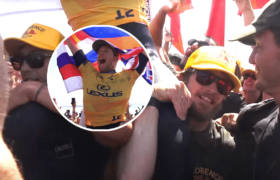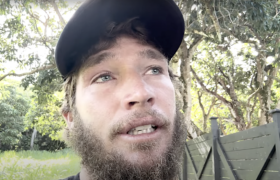Or how the world’s most enduring sex symbol almost
inspired the modern shortboard…
History bounces in weird ways.
Opportunities are missed, opportunities are made, people zig
when they should zag, sometimes they end up in the mud, sometimes
they make history.
Around Malibu, there are a lot of surfers riding a lot of
different surfboards, but all of them (except the alaia flyahs) can
trace their ancestry back to a time in the late 1940s when
California surfers were flying straight and fast on 11-foot boards
that weighed as much as 100 pounds – but they wanted something
different.
That something different was inspired by a woman who was surfing
around Malibu and if history had bounced a little differently, that
woman could have been Marilyn Monroe.
Sweet Sixteen is my title for a found reel of late-40s
surfing footage that was discovered in Malibu in 2004. Sweet
Sixteen stands for the 16 minutes of 16 mm film shot by a
Malibu/Latigo Shores resident named John Larronde, although surf
historians who have seen the footage think it was shot by God,
because whoever filmed those epic overviews of empty, perfect
Malibu and Rincon and double overhead Ventura Overhead reeling both
ways, not only knew how to handle a film camera, they also knew
what surfers and spots and boards and jalopies and girls would make
surf historians do backflips, sixty years later.
Sweet Sixteen has several shots of a tall, strong
Nordic man tandeming from the top of First Point to the beach with
a svelte, pretty woman in a bathing cap standing on his
shoulders.
The man is Pete Peterson, and the woman…. Well it’s not Marilyn
Monroe and that’s a shame, because it could have been.
And if things had worked out a little different back then – and
certain guys had dated certain girls – Marilyn Monroe might have
had a profound effect on surfboard design as the girl who inspired
the short board.
Gerry Lopez once called Tommy Zahn, “the greatest surfer in the
world… because he (word censored at request of Gez!) Marilyn
Monroe.”
It’s true Zahn and Marilyn were in close contact. Zahn was a
first-rate waterman who was movie-star handsome – the Laird
Hamilton of the thirties and forties. He and Norma Jean Baker were
hired at 20th Century Fox at the same time, and some say it was a
love triangle between Zahn, Norma Jean and Darrilyn Zanuck – the
daughter of studio head Darryl Zanuck – that got both Norma Jean
and Zahn fired from the lot.
Regarding Norma Jean Baker, Tommy Zahn was quoted in the book
Goddess: The Secret Lives of Marilyn Monroe by Anthony
Summers,
“She was in prime condition. Tremendously fit. I used to take
her surfing up at Malibu-tandem surfing: you know, two riders on
the same surfboard. I’d take her later, in the dead of winter when
it was cold, and it didn’t faze her in the least; she’d lay in the
cold water, waiting for the waves. She was very good in the water,
very robust, so healthy, a really fine attitude towards life. I was
twenty-two when I met her and I guess she was twenty. Gosh, I
really liked her.”
Craig Stecyk told a similar story in The Surfer’s Journal,
“A strikingly beautiful woman approaches Dave Rochlen on the
beach and inquires as to the maker of his surfboard. He informs her
that he builds his own and she responds that she would like to
place an order. That evening, the lady shows up at Rochlen’s board
building area (located in his girlfriend Honey Bear Warren’s
garage) with her husband in tow. The man orders up one as well, and
is a friendly sort. This fellow finds it interesting that Rochlen
is crafting surfboards in the garage of the Governor of the State
of California. Dave finds it noteworthy that the fellow is none
other than matinee idol, Gary Cooper.”
Another tale is told of Tommy Zahn and Dave Rochlen surfing
Malibu Point on August 16, 1947; a continuation of the Marilyn
Monroe story,
“The point. Evening, full moon. Two surf dogs do a double date
in a 1934 Ford Roadster, with boards in the back,” wrote Craig
Stecyk. “The men: Tom Zahn and Dave Rochlen. The women: Darrylin
Zanuck (daughter of ‘movie czar’ Richard Zanuck) and Norma Jean
Baker. Tom and Darrylin have fixed ‘Rocky’ up with Norma Jean
Baker, later to be better known as Marilyn Monroe.”
Apparently, Zahn and Norma Jean and Zanuck got that love
triangle patched up, so it was Darrilyn Zanuck and not Norma Jean
Baker/Marilyn Monroe who would prove to be the Eve of the modern
shortboard.
In Sweet Sixteen, there is a shot of three people
sitting on the beach, two men playing ukuleles and one girl between
them, looking at the guy on the left. He’s Tommy Zahn, tan and fit
and looking like a movie star. After that, there is a shot of a
woman paddling into an inside wave at Malibu on a shorter board,
getting clumsily to her feet and then riding with style down the
beach.
Is that Darrilyn?
And is that the Darrilyn board?
During the summer of 1947, Tommy Zahn asked Joe Quigg to make a
“novice girls’ board” for Darrilyn. It had to be short and light,
easy for a girl to carry and it had to fit in the back of a Town
and Country convertible.
Thinking about Darrilyn Zanuck many years later, Joe Quigg said
to Malcolm Gault-Williams,
“She probably thinks of herself as the original Gidget. She was
at Malibu, really the first girl to buy a surfboard and buy a
convertible and stick the surfboard in the back and drive up to
Malibu and drive up and down the coast and learn to surf. Of the
Malibu girls she was the first Malibu girl to really do it.”
This was a special board for his best friend’s girl, so Quigg
picked the best redwood and balsa from five different lumber yards
and made a 10’ 2” redwood/balsa with 50/50 rails, curved rail
rocker, a flat planning bottom and a fin.
The board was soon nominated “the loosest board on the West
Coast” and you wonder how much Darrilyn actually got to ride it. As
the story goes, after Zahn and Darrilyn broke up, Darrilyn pulled a
commando raid on Zahn’s garage to get the board back.
In August of 1947, the Los Angeles surf crew took a surfari down
to San Onofre. Dave Rochlen, Kivlin and Pete Peterson borrowed that
“novice girls’ board” and proceeded to invent California
hotdogging, right then and there.
The board was faster and more manoeuvrable than anything else in
the water.
“It is immediately apparent that Rochlen is turning four times
faster and making it into and out of what would previously have
been inconceivable situations,” Craig Stecyk wrote. “Pete Peterson
next borrows the board, and is instantly banking and turning in an
obvious departure from his patented power trim, runaway style.
Kivlin is intrigued and promptly decides to have one for his girl
friend.”
The board is even lighter than the most advanced Simmons model –
maybe because Simmons still thought heavier boards were better.
Quigg said the board had “the complete combination” and he
called it The Easy Rider,
“I’d been building girls’ boards since early ’47,” Quigg told
surf journalist Paul Holmes. “It helped the girls to leave the
tails wide. I’d put what I called ‘easy-rider’ rocker in them. They
were real easy to ride. A lot of girls learned how to surf on those
boards in just a few months.”
The Darrilyn Board is considered the precursor of modern
shortboards because it was at that point that the best surfers in
California figured out that less was more, that they didn’t need
11-foot, 100-pound planks to make waves from the flagpoles to the
pier.
That same year, Quigg, Kivlin and Zahn took their first trip to
Hawaii. On the way over, Quigg sketched out a narrow board with a
pintail, which Quigg thought might be good for speed on those
bigger days at Malibu and Rincon.
From there, surfboards transformed fast from planks, and
inevitably to plastics.
And if Tommy Zahn had changed his dating habits a little, the
mother of all modern shortboards could have been one of the
greatest of all American movie stars.







